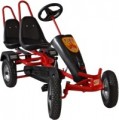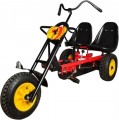Age group, from
The minimum age from which it is recommended to use a velomobile. Of course, this indicator is rather conditional: children can grow and develop faster than the norm, and it is possible that the car may be quite suitable a few months before the calendar birthday. Nevertheless, it is still not recommended to violate these recommendations: each age category requires the presence of certain skills, as well as compliance with height and physique; therefore, using the velomobile too early can be difficult, inconvenient, and even dangerous.
The age group is to some extent associated with the appointment (see below). So, children's models mainly have a minimum age of
2 to
3 years, the maximum for them is
4 years. The same age is the smallest found among teenage velomobiles, and universal ones belong to groups of
5 years and
older.
Suitable for
User group for which the velomobile is designed. This parameter is associated not only with the age category of riders (see above), but also with the set of features provided in the car.
— Children's. The simplest and, usually, inexpensive type of velomobiles. The latter is associated not only with small size (length, usually, does not exceed 110 cm), but also with a rather modest set of additional features. And the maximum load in such models is small - in most cases it does not exceed 50 kg. Note that most of these machines provide a seat adjustment function - it allows you to adjust the seat for a constantly growing child. However, occasionally there are velomobiles without such adjustment.
— Teenage. Transitional class between children's and universal models. In this case, teenagers mean children 8–12 years old, and this type of velomobile is designed for them (although the age group can start from an earlier age, see above for more details). However the maximum load in such models can exceed 100 kg, but such indicators are not so much an intentional step of manufacturers as a “side effect” of large structures, and do not yet mean that the machine is suitable for an adult. The length of most models is about 130 cm, they can use additional features that are not found in children's rooms - in particular, this class includes not only single, but also double models (see "Number of seats").
— Universal. Also, this variety is called "adult...s" - for the reason that both children and adults can ride such machines. Universal models have large sizes, corresponding maximum load indicators and an abundance of adjustments to adjust to riders of different ages and physiques; and the number of seats can reach 4. However, such velomobiles cost accordingly.
Design
The appearance is usually described based on the vehicle that inspired the design and construction of the velomobile.
—
Cards(bodyless). Go-karts are four-wheeled racing cars that do not have a body. Accordingly, in velomobiles of this type, the basis of the design is a special frame on which the driver’s seat is installed. The cards are simple in design and management, yet quite durable and reliable and can even be used for universal purposes (see above), which is why this type of design is very popular.
- Automobile. Models that imitate ordinary passenger cars. As a rule, such similarities are quite conditional. The basis of the design is the body, the role of the seat is played by a part of this body, made in the form of a platform, and the pedals are located under the “hood”. For a number of reasons, this appearance is used mainly in children's velomobiles and is not typical for other purposes.
-
SUV. Models that imitate off-road vehicles (in addition to SUVs, they are also called jeeps). The design and practical features are similar to the cars described above, they differ from them only in the characteristic design with the corresponding wheels (see “Type of wheels”), imitation of safety bars (not to be confused with real bars - see below), additional headlights and other “off-road” accessories.
- Quad bike. ATVs are vehicles on four wheels on which the dr
...iver sits astride, like on a motorcycle. Velomobiles in this design also have a corresponding design - only the pedals play the role of footrests. ATVs are found mainly among children's models, less often among teenagers.
- Trike. In this case, a trike means a rather unique type of three-wheeled vehicle: the driver sits reclining, the pedals are placed in front and the drive from them is transferred to the front wheel (in models of the younger age category - directly, as in tricycles, in older ones - through a chain drive) , and there is no steering wheel as such - the front wheel is turned by the force of the legs. Thanks to this, trikes are good for developing balance control. On the other hand, non-standard controls can cause certain difficulties, so such machines are relatively rare.
- Tricycle. Design based on a three-wheeled motorcycle - one wheel in front, two in back. The layout of tricycles is more traditional than the trikes described above: they have a motorcycle handlebar, and the rider’s position is a classic sitting one.
- Special equipment. Models that copy various specialized equipment that does not fall into the categories described above. The most popular option is a variety of tractors and bulldozers, but other varieties can also be found, such as fire trucks or combine harvesters. Some of these models, in fact, are classic karts, only in a specific coloring and with tractor wheels (see “Type of wheels”), others have an original design, more reminiscent of real tractors or other equipment. Another feature of “special equipment” is the extensive use of trailers (see below) and various additional equipment - excavator buckets, bulldozer blades, etc. This gives the little driver additional opportunities for games (in fact, the purpose of velomobiles of this type is mainly for children).Maximum weight
The greatest weight that a velomobile is able to carry for a long time without breakage, in other words, the maximum load on the structure that is permissible for normal operation. This load takes into account the weight of the driver, luggage, and in multi-seat models, passengers as well (that is, it is indicated for the car as a whole, and not for a separate seat). This parameter is connected primarily with the purpose and age category (see above): the “older” the velomobile is, the more weight it should normally carry.
Of course, when choosing a machine, one should proceed from the fact that the maximum load indicated in the characteristics should not be lower than that planned in real conditions; but at the same time it is desirable to have also a certain reserve. This is related to two things. Firstly, this parameter is usually given for flat roads; and when driving through pits, potholes and other irregularities, the velomobile may be subjected to off-design loads even with a formally permissible weight. Secondly, most often velomobiles are bought for children; and as children grow up, a margin of weight is simply a must — otherwise the machine will very quickly become unusable.
Also, do not be deceived if, when the maximum load (accidental or intentional) was exceeded, the velomobile did not break down immediately — overload anyway negatively affects reliability and can lead to early breakdown.
Adjustable handlebar
The ability
to adjust the position of the steering wheel of the velomobile.
This adjustment can be done in different ways: in some models, the length of the steering column changes, in others — tilt, and in some places these possibilities can even be combined. Anyway, this function provides additional features for adjusting the velomobile to the height and physique of a particular rider (for more details on the features of any such adjustment, see "Adjustable Seat").
Safety arc
The presence of a
safety arc in the design of the velomobile.
Such an arc is usually installed in the back of the velomobile, behind the seat. Its task is to protect the head and neck of the rider when the car rolls over. Note that safety arcs are also sold separately, and many models without this feature allow the installation of purchased fixtures; however, it is usually easier to immediately purchase a velomobile with an arc in the kit.
Front wheel diameter
The diameter of the front wheel(s) of a velomobile. In fact, this parameter is important, first of all, taking into account the fact that large wheels have a higher cross-country ability than small ones. In addition, data on the dimensions of the front and rear wheels make it possible to evaluate the appearance features (see above): for example, some
"special equipment" may have small front wheels and large rear wheels, like in real tractors.
Rear wheel diameter
The diameter of the rear wheel(s) of a pedal car. The value of this parameter is the same as the diameter of the front wheel (see the relevant paragraph).
Wheel design
Appearance describes not only the general design of the wheels, but also some specifics of their functionality.
— Bicycle. Bicycle wheels have two key distinguishing features: the presence of separate spokes connecting the rim to the centre of the wheel, and a relatively small width (due to which they are poorly suited for off-road). However, the width in different models may be different; the same applies to the size, shape and number of spokes.
— Automotive. Wheels, the disk of which does not have pronounced spokes, and the overall width, usually, is greater than that of the bicycle wheels described above. In this case, the disk can be either solid or with slots. Similar discs are also used in off-road and tractor wheels (see below), but a distinctive feature of automotive varieties is the tread pattern - it is either shallow (on "universal" tyres and some racing tyres) or not at all (this option is found in entry-level models) . Thus, the main purpose of such wheels are relatively flat surfaces.
— Off-road. Wheels with a solid (or almost solid) disk, which differ from the automobile wheels described above by a deeper tread pattern, and sometimes by larger sizes. This design is designed to make it possible to successfully move not only on smooth asphalt, but also on rough terrain such as dirt roads or even off-road (although without much “fanaticism” - for example, such wheels are usually not intended for deep mud). ). At the same time, note that...in the simplest velomobiles designed for children (see "Destination"), off-road wheels can be a dummy, designed solely to provide an external resemblance to a real all-terrain vehicle; in terms of driving characteristics, in such cases they do not have advantages over automobile ones.
— Tractor. Further development of the idea of off-road wheels (see above). Tractor varieties are distinguished by a deep tread pattern with powerful lugs, as well as an even larger size. Thanks to this, full-fledged tractor wheels are able to successfully overcome not only dirt roads, but also difficult obstacles such as puddles, viscous wet earth, etc. However, this category also includes another variety - wheels that only imitate tractor wheels and are not intended for difficult conditions. They are found in children's models of velomobiles (see "Intended use").
Note that some models can combine bicycle and car wheels in their design (other combinations are not found for a number of technical reasons. In such cases, the type of wheels is indicated according to the majority principle - for example, for a trike with two rear wheels of an automobile type and the front bike will be indicated exactly the car.

